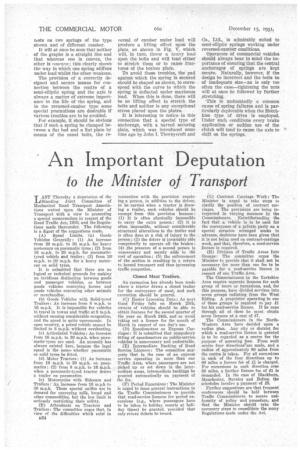An Important Deputation
Page 52

If you've noticed an error in this article please click here to report it so we can fix it.
to the Minister of Transport
TAST Thursday a deputation of the 4 Standing Joint Committee of Mechanical Road Transport Associations waited upon the Minister , of Transport with a view to presenting a special memorandum in respect of the Road Traffic Act, 1930, and the Regulations made thereunder. The following is a digest of the suggestions made.
(A) Speed Limits. (a) Goods Vehicles Generally : (1) An increase from 20 m.p.h. to 30 m.p.h. for heavy motorcars on pneumatic tyres; (2) from 16 m.p.h. to 20 m.p.h. for pneumatictyred vehicle and trailer ; (3) from 10' m.p.h. to 20 m.p.h. for a heavy motorcar on solid tyres.
It is submitted that there are no logical or technical grounds for making an invidious distinction between goods and passenger vehicles, or between goods vehicles conveying horses and goods• vehicles conveying other animals or merchandise.
(h) Goods Vehicles with Solid-tyred Trailers: An increase from S m.p.h. to 16 m.p.h. It is impossible for vehicles to travel in towns and traffic at 8 m.p.h. without causing considerable congestion, and the ,speed is quite uneconomic. In open country, a petrol vehicle cannot he limited to 8 m.p.h. without overheating.
(c) Articulated Vehicles: An increase from 16 m.p.h. to 20 m.p.h. when pneumatic tyres are used. An anomaly has always existed here, because the legal speed is the same. whether pneumatic or solid tyres he fitted.
(d) Motor Tractors: (1) An increase from 16 m.p.h. to 20 m.p.h. on pneumatics; (2) from 8 m.p.h. to 16 m.p.h. when a pneumatic-tyred tractor draws a trailer an pneumatics.
(e) Motorcycles with Sidecars and Trailers: An increase from 16 m.p.h to 30 m.p.h. These special outfits are in demand for conveying mint, bread and other commodities, but the low limit is seriously restricting their utility.
(E) Attendants on Tractors and Trailers: The committee urges that, in view of the difficulties which exist in B34 connection with the provision requiring a person, in addition to the driver, to be carried when a tractor is drawing a trailer, such vehicles should be exempt from this provision because: (1) It is often physically impossible to carry the extra person ; (2) it is often impossible, without • considerable structural alterations to the trailer and is often done at a risk of injury to the person.; (3) the driver is invariably able competently to operate all the brakes; (4) the presence of a second person is unnecessary and merely adds to tie cost of operation; (5) the enforcement of the section is resulting in a return to horsed transport and thus increasing traffic congestion.
Closed Meat Trailers.
An exemption has already been made where a tractor draws a closed trailer for the conveyance of meat, and such exemption should be general.
(C) Easter Licensing Date: As next Good Friday falls on March 25th, owners of vehicles should be able to obtain licences for the second quarter of the year On March 24th, and so avoid taking out a licence for the month of March in respect of one day's use.
(D) Speedometers on Express Carriages: It is submitted that compulsory fitting of speedometers on public-service vehicles is unnecessary and undesirable.
(E) Intermediate Backing of Road Service Licences: The committee suggests that in the ease of an express service operating in more than one Traffic Area, where passengers are not picked up or set down in the intermediate areas, intermediate backings be granted automatically on payment of the fee.
(F) Period Excursions : The Minister is urged to issue general instructions to the Traffic Commissioners to provide that road-service licences for period excursions (e.g., where passengers have to be taken to holiday resorts at holiday times) be granted, provided that only return tickets be issued.
(G) Contract Carriage Work: The Minister is urged to take steps to clarify the position of contract car
riages. The provisions are being interpreted in varying manners by the Commissioners. Notwithstanding the fact that a vehicle is to be used for the conveyance of a private party on a special occasion arranged weeks in advance, decisions have been given that it is not being used on contract-carriage work, and that, therefore, a road-service licence is required.
(H) Division of Traffic Areas Into Groups: The committee urges the Minister to provide that it shall not be necessary for more than one fee to be payable for a road-service licence in respect of one Traffic Area.
The Commissioners in the Yorkshire Area require separate licences for each group of tours or excursions, and, for this purpose, have divided services into seven groups radiating from the West Riding, A proprietor operating in one of these groups is required to pay a for his road-service licence. If he runs through all of them he must obtain seven licences at a cost of f7.
The Commissioners in the NorthWestern Area have decided upon a radius plan. Any city or district for which a road-service licence is granted is to be regarded as a centre for the purpose of assessing fees. From such centre four directions/are made, and a radius of approximately 80 miles from the centre is taken. For all excursions in each of the four directions up to 80 miles a licence fee of £1 is charged. For excursions in each direction over 80 miles, a further licence fee of £1 is demanded. In the case of Blackburn, Manchester, Burnley and Bolton the schedules involve a payment of £8.
Further suggestions are that frequent conferences should be held between Traffic Commissioners to secure uniformity of policy and procedure, and that the Minister should take the necessary steps to consolidate the manyRegulations made under the AO.




































































































